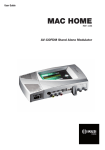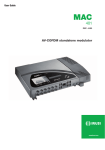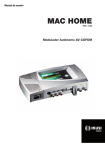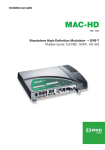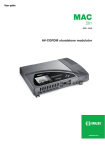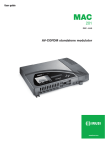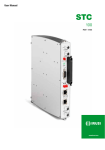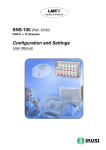Download MAC AV-COFDM User guide
Transcript
User Guide MAC HOME REF. 4488 AV-COFDM Stand Alone Modulator 2 16 Contents 4 General safety instructions 4 Types of notices 4 Basic safety instructions 5 Introduction 5 General description 5 Main features 6 Technical specifications 6 MAC HOME Model 7 Unit installation and configuration 7 Installation 7 Power supply connection 8 Cascade installation 8 General use of the unit 9 Fast menu guide 10 Initial configuration of the unit 10 Advanced configuration of the unit 10 Blocking the LCD and Joystick 11 Firmware update 11 Configuration of the input signals 11 Configuration of the carrier services 12 Configuration of the output signal 12 Network configuration 14 Status of the unit 14 Unit information 14 Unblocking the unit 15 Maintenance 15 Unit care 15 Troubleshooting 15 Warranty 15 Unit recycling 16 CE Certificate 17 Safety instructions 17 General safety instructions JJ Read all of this user manual carefully before plugging in the unit. JJ Always have these instructions to hand during installation. JJ Follow all of the instructions and safety notices regarding unit handling. Types of notices The meaning of the safety notices used in this manual are described below. DANGER of DEATH OR INJURY DANGER This safety notice indicates a possible danger for the life and health of people. Not following these instructions may lead to serious consequences to health and may even cause fatal injuries. RISK OF damage to the unit ATTENTION This safety notice indicates a possible dangerous situation. Not following these instructions may lead to the unit being damaged. NotE This type of notice is a note containing applicable advice and useful information for optimum use of the unit. HANDLING THE INSIDE OF THE UNIT IS FORBIDDEN This notice forbids any work that may affect the working order of the unit or its warranty. DO NOT DISPOSE OF AS URBAN WASTE This type of notice indicates that the unit must not be disposed of as unselected urban waste. Basic safety instructions DANGER of DEATH OR INJURY JJ DANGER JJ Do not install the unit during an electrical storm. This could lead to electrostatic discharge from lightning. Do not open the unit. There is a risk of electrostatic discharge. RISK OF damage to the unit JJ The unit must be appropriately ventilated. Install the unit in a dust-free location. Do not place the unit in a location where the ventilation slots are covered or blocked. Install the unit in a location with at least 20 cm around it free of other objects. JJ Do not expose the unit to rain or moisture. Install the equipment in a dry location with no infiltration or condensation of water. Should a liquid enter the unit, disconnect it immediately from the mains. ATTENTION 18 JJ Keep the unit away from flammable objects, candles and anything that may cause a fire. JJ Connect the unit to an easily accessible power socket. In the event of an emergency, it will then be possible to quickly unplug the unit. JJ Do not expose the unit to sources of heat (sun, heating, etc.). Introduction General description KEY Power Supply Display (LCD) Control button Mains connector S-Video & component Video (YPbPr, RGB) C-VBS vídeo input L & R analogic audio inputs USB input (firmware actualization) TV Loopthrough input TV COFDM output Main features The MAC HOME model is an AV analogue TV signal to COFDM digital TV signal standalone modulator unit. Suitable for individual residential installations, it is an ideal solution for the distribution of analogue video signals with COFDM digital TV modulation in a single standalone unit. The AV signal is digitalised, coded in MPEG2 MP@ML, H.264/MPEG4 AVC MP L4.1 and modulated in COFDM. The COFDM base band signal is modulated on an RF carrier that can be adjusted at the output to the UHF bands. FF Programming: FF User interface with LCD display and control button for basic configuration. FF All settings are automatically memorised. FF Reprogrammable as many times as required. FF Firmware update via USB connection. 19 Technical specifications MAC HOME Input AV CVBS, S-VIDEO, YPbPr, RGB Format Input level (video) Vpp Input impedance Ω Video standards 75 PAL/SECAM/NTSC/B&W Audio standards Input level (audio) 0.7 ... 1.4 1 x mono/stereo Vpp 0.5 ... 2.5 Compresion Video MPEG2 MP@ML, H.264/MPEG4 AVC MP L4.1 Video resolution 720x576, 25 fps (PAL), 720x480, 30 fps (NTSC) Video Bitrate MBits/s Audio Audio Bitrate 4 - 10 MPEG1 Layer II KBits/s 96, 128, 160, 192, 224, 256, 320, 384 DVB Processing Insertion tables Configuration PAT, PMT, SDT, NIT Channel Name, SID, LCN, NID, Network Name, Provider Name, TSID, ONID, NIT MODE, LCN Private Descriptor Output Bandwidths DVB-T according to ETSI EN 300 744 MHz Number of carriers 6/7/8 2K / 8K dB ≥ 35 Central frequency MHz 474 - 858 Level dBμV ≥ 80 MER Output pitch attenuation dB 1.5 Level adjustment dB -25 Frequency stability ppm ≤ ±30 Noise figure (∆B = 8 MHz) dBc ≤ -45 230 - 240 Operations Mains voltage VAC Consommation W 8.1 Operating temperature ºC 0 to 45 Mains connector 20 IEC C8 Unit installation and configuration The LCD display and the control button are sufficient for the basic settings of the unit. Follow the steps indicated below to install the unit and configure the various parameters accessible from the user interface on the LCD display. Installation 1 RISK OF damage to the unit 3) Optionally, connect the loop-through RF input coaxial cable (F connector). CAM USB audio R vídeo 2) Connect the AV input in the respective RCA connectors or S-Video connector. audio L 1) Mount and tighten the screws and plugs (not supplied) to secure the unit to the wall. (*) Ref.4488 AV COFDM MODULATOR S-Video ATTENTION Mechanically handling the unit may result in damage. Do not connect the unit to the power supply before or during assembly. DVD 3 IRD 4 2 4) Connect the coaxial output cable to the unit (F connector). (*) The 3 wall attachments are supplied disassembled in order to install the unit horizontally. The straightforward assembly consists of positioning the fastenings in the corresponding holes and pushing as far as possible (they cannot be removed once inserted). Power supply connection DANGER of DEATH OR INJURY DANGER Incorrect unit power connection may cause an electric shock. Follow the steps below for the electrical installation of the unit. 1) Connect the earth cable. 2) Connect the power plug to the unit mains connector. 3) Connect the power plug to the mains socket. 21 Cascade installation The MAC HOME unit has 1 AV analogue TV signal to RF UHF output encoded as COFDM Digital TV signal. Several MAC HOME units can be cascaded in order to increase this capacity. The maximum capacity of a series of N units is 1xN incorporated TV signals. To cascade 2 or more units, connect the RF output of the preceding unit to the TV input (loop-through) of the next unit (see illustration). The MAC HOME unit automatically adjusts the TSID and SID values when programming the channel of each modulator. General use of the unit Below is described how to operate the unit using the control button and interpret the visual indications on the LCD display. The program comprises a main menu made up of sub-menus that can be selected to modify the basic operation settings of the unit. Visual indications on the LCD display In the menus and submenus, move the button up or down to browse upwards and downwards position by position.J In the settings, move the button up or down to modify values position by position. Keep the button pressed up or down to browse or to modify values more quickly Horizontal button movement In the menus, move the button to the left or the right to select and go back position by position.J In the settings, move the button to the left or the right to select and go back position by position. Keep the button pressed to the left or to the right to browse more quickly. Press button In the menus, this selects the submenu.J In the submenus, this selects the setting.J In the settings, this selects the parameter value. 22 Fast menu guide INITIAL Installation IKUSI MAC Stating ... COUNTRY insert country COUNTRY AUSTRALIA COUNTRY LANGUAGE COUNTRY SPAIN MAC HOME 1.00 CH21 SYSTEM OK CHANNEL 21 OUTPUT CHANNEL ATTENUATION ATTENUATION 1.00 dB THE EQUIPMENT IS INSTALLED main menu ADVANCED Installation MAC HOME 1.00 CH21 SYSTEM OK OUTPUT CHANNEL ATTENUATION COUNTRY LANGUAGE ADVANCED MODE GENERAL SETTINGS INPUT SERVICES STATUS MODULE INFO OUTPUT NETWORK submenu GENERAL LOCK CODE LOCK CODE 0000 ** INFORMATION SERIAL NUMBER 012345678911 LOCK LCD LOCK CODE OFF 000O FACTORY RESET SYSTEM UPDATE ** MAC HOME 1.00 WARNING ** CANCEL FORMAT WARNING ** CANCEL UPDATE NO USB STATUS SETTINGS INPUT SERVICES CH VIDEO AUDIO ON OFF CH LCN 001 CH SID 0021 CH NAME CH1 CH1: PAL BRIGHT V:X A:X 128 CONT SATURATION 066 063 INP AUDIO ATT 20 SHARPNESS MEDIO STATUS: OK ALARM: OK AV MODE AUTO CHANNEL 21 NETWORK FREQUENCY 474.000 MHz OUTPUT BITRATE 31.670 MBits/s NAME Standard ACT MIN NULL MAX 100% 100% 100% PROVIDER IKUSI NID 00001 CODING MPEG2 ASPEC RATIO 4:3 OUTPUT MODULE INFO MODEL MAC HOME STANDARD TV PAL SERIAL NUMBER 012345678911 VIDEO BITRATE 08.000 MBits/s V.SW V.HW V.BS 1.00 1.01 2.32 TSID 00001 ONID 00001 NIT MODE OFF ATTENUATION 12 dB OFDM MODE 2K BANDWIDTHS 8 MHz GUARD INTERVAL 1/32 CONSTELLATION 64 QAM CODE RATE 7/8 NIT LCN MODE Europa MODE AUDIO BITRATE 128 KBits/s 23 MAIN MENU NotE Over the following pages, the field locating and selection method is primarily indicated by the “vertical button movement” and “press button” icons. 1) Once the unit is started up, the start screen asks for the COUNTRY to be entered. Move the button to the right and the cursor will flash next to the first country, then move the button down until you find the reference country. OK to save * The unit automatically adjusts to the technical peculiarities of this (see default parameters table). 2) Move to the left and place the arrow on LANGUAGE, then move the button to the right and locate the required language by moving the button vertically. OK to save. 3) Move to the left through to the start screen, which shows the model, firmware version, channel and status. STATUS: SYSTEM OK = status correct. NO input = input signal not detected SYSTEM no OK = status incorrect. Configuration of the output signal 1) From the start screen, move the button to the right through to the OUTPUT CHANNEL. The cursor will blink next to the channel. 2) Use horizontal scrolling to move between the digits and vertical scrolling to change the value. OK to save. COUNTRY insert country COUNTRY AUSTRALIA COUNTRY LANGUAGE MAC HOME 1.00 CH21 SYSTEM OK OTPUT CHANNEL ATTENUATION CHANNEL 21 THE UNIT IS INSTALLED! ADVANCED MODE From the start menu, move a step to the right and down to locate the ADVANCED MODE screen. GENERAL From the GENERAL screen, move the button to the right to access the following menus: Block the LCD and Joystick 1) Locate and select the option LOCK LCD to block access to the configuration of the unit from the LCD display and using the control button. a) Enable (ON) or disable (OFF) the blocking option. b) Set a code to unblock the unit whenever this option is enabled. Restoring factory setting 1) Locate and select the option FACTORY RESET to restore the factory settings of the unit. Select the option FORMAT to delete all the modifications entered in the configuration by the installer or operator of the unit. MAC HOME 1.00 CH21 SYSTEM OK ADVANCED MODE GENERAL SETTINGS BLOCK LCD RESET FABRICA LOCK CODIGO 000O OFF GENERAL SETTINGS ** 24 LOCK LCD FACTORY RESET WARNING ** CANCEL FORMAT Firmware Update 1) Locate and select the option SYSTEM UPDATE. a) Download the update package from the website. b) Place in the root directory of a USB. c) Insert the USB in the connector in the unit. SYSTEM UPDATE ** WARNING ** CANCEL UPDATE SETTINGS THE SIGNALS NotE The unit can switch the input signals; alter their brightness, contrast and saturation conditions; and adjust the output carrier in RF. Locate and select the option SETTINGS Configuring the input signals 1) Locate and select the option INPUT. a) Locate and select the option CH1 BRIGHT to check the type of input signal (PAL), the video (X) and audio (X) detection, and configure the brightness of the video signal (1 to 255). b) Locate and select the option CONT SATURATION to configure the contrast and saturation of video signal (1 to 255). c) Locate and select the option INP AUDIO ATT to configure the attenuation of audio signal in dB (1 to 40). d) Locate and select the option SHARPNESS to configure the sharpness of video signal (High, Medium soft or None). e) Locate and select the option CODING. This configures the coding parameters: MPEG2 H.264/MPEG4 AVC. f) Locate and select the option ASPECT RATIO. The possible aspect ratio values are 4:3 and 16:9. g) Locate and select the option AV MODE. The possible values are AUTO (automatically detects the signal type, excepting RGB), C-VBS, S-Video, YPbPr, RGB. h) Locate and select the option STANDARD TV. The possible values are PAL and NTSC,(automatically updated when you change the country). i) Locate and select the option VIDEO BITRATE. The unit can be configured for a data coding speed at input of 4 to 10 Mbits/s. j) Locate and select the option AUDIO BITRATE. The unit can be configured for a data coding speed at input of 96; 128; 160; 192; 224; 256; 320 and 384 Kbits/s. GENERAL SETTINGS INPUT SERVICES CH1: PAL BRIGHT V:X A:X 128 CONT SATURATION 066 063 INP AUDIO ATT 20 SHARPNESS NONE CODING MPEG2 ASPECT RATIO 4:3 AV MODE AUTO STANDARD TV PAL VIDEO BITRATE 08.000 MBits/s AUDIO BITRATE 128 KBits/s NotE If you keep pressing the control button down you will accessthe information and configuration of the following input signals. Configuration of the carrier services 1) Locate and select the option SERVICES. a) Locate and select the option CH VIDEO AUDIO. Activate (ON) or deactivate (OFF) the video and audio signals of the first input. INPUT SERVICES CH VIDEO AUDIO ON OFF 25 b) Locate and select CH LCN. Configure the LCN value of the signal. c) Locate and select CH SID (used by default as output channel). Service set identifier. d) Locate and select CH NAME. Assign a name to the signalJ in CH. NotE CH LCN 001 CH SID 0021 CH NAME CH1 If you keep pressing the control button down you will access the information and configuration of the following input signals. Configuration of the output signal NotE To introduce a sequence of digits in the display move the control button vertically to change the value of the current digit and horizontally to move between digits. NotE Position the cursor to the right of the current value and move the control button vertically to increase or decrease the current value. Hold the control button up or down to increase or decrease the current value more quickly. 1) Locate and select the option OUTPUT. a) Locate and select the CHANNEL. This option automatically changes the frequency, adapting to the center of the channel. b) Locate and select the option FREQUENCY. This option modifies the value of the channel, adapted to the frequency. Configure the output frequency value between 474 MHz and 862 MHz increments of 125 kHz. c) Locate and select the option ATTENUATION. Select the output attenuation between 0 and 25 dB. d) Locate and select the option OFDM MODE. Select the OFDM mode between 2K and 8K subcarriers. e) Locate and select the option BANDWIDTH. Select the bandwidth between 6, 7 and 8 Mhz. f) Locate and select the option GUARD INTERVAL. Select the guard interval between 1/32, 1/16, 1/8 and 1/4 of symbol. g) Locate and select the option CONSTELLATION. Select the modulation constellation between 16QAM and 64QAM. h) Locate and select the option CODE RATE.J Select the code rate between 1/2, 2/3, 3/4, 5/6 and 7/8. Network configuration OUTPUT NETWORK CHANNEL 21 FREQUENCY 474.000 MHz ATTENUATION 1.00 dB OFDM MODE 2K BANDWIDTH 8 MHz GUARD INTERVAL 1/32 CONSTELLATION 64 QAM CODE RATE 7/8 Note To introduce a sequence of digits in the display move the control button vertically to change the value of the current digit and horizontally to move between digits. 26 Note Position the cursor to the right of the current value and move the control button vertically to increase or decrease the current value. Hold the control button up or down to increase or decrease the current value more quickly. 1) Locate and select the option NETWORK. a) Locate and select the option NAME. Configure the name of the network. b) Locate and select the option PROVIDER. Configure the name of the network service provider. c) Locate and select the option NID. J Configure the value of the network identifier. d) Locate and select the option TSID. Configure the value of the trasport stream identifier. e) Locate and select the option ONID. Select the guard interval between 1/32, 1/16, 1/8 and 1/4 of symbol. f) Locate and select the option NIT MODE. Configure the NIT mode : OFF: NIT is not inserted (the LCN values are ignored). ON: the NIT generated by the unit is inserted. OUTPUT NETWORK NAME Standard PROVIDER IKUSI NID 00001 TSID 00001 g) Locate and select the option NIT LCN MODE. Allows you to select the mode of the NIT LCNs : OFF: the LCN descriptor is not inserted in the NIT EUROPE MODE: the descriptor for Europe is inserted. INDEPENDENT TELEVISION COMISION: the descriptor for the UK is inserted. NORDIG MODE V1: the descriptor according to the Nordig V1 specification is inserted. NORDIG MODE V2: the descriptor according to the Nordig V2 specification is inserted. GENERIC MODE: generic LCN descriptor. ONID 00001 NIT MODE OFF NIT LCN MODE Europe Mode DEFAULT PARAMETERS TABLE IN ACCORDANCE WITH THE COUNTRY SELECTED COUNTRY LANGUAGE NIT MODE LCN MODE NID TSID ONID Bandwidth Channels Frequencies Standard TV Australia English ON Generic 1 28 8442 7 Mhz 28 - 69 526000 - 819875 PAL France French ON Europe 1 21 8442 8 Mhz 21 - 69 470000 - 861875 PAL UK English ON Ind Tl Com (UK) 1 21 8442 8 Mhz 21 - 69 470000 - 861875 PAL Italy Italian ON Europe 1 21 8442 8 Mhz 21 - 69 470000 - 861875 PAL Portugal English ON Generic 1 21 8442 8 Mhz 21 - 69 470000 - 861875 PAL Spain Spanish ON OFF 1 21 8442 8 Mhz 21 - 69 470000 - 861875 PAL Note: When configuring the country, the unit is always configured with the first channel allowed, using the frequency of the centre of this channel. This is 529.5 MHz for Australia and 474 MHz for the others. 27 STATUS OF THE UNIT NotE The unit lets you see its status in detail and the existence of active alarms in the module. 1) Locate and indicate STATUS. a) Locate and indicate STATUS: The unit displays its status and alarms: OK / Error. b) Locate and indicate OUTPUT BITRATE. The unit displays the output data speed in Mbits/s. c) Locate and indicate MIN ACT MAX NULL. The unit displays the volume of null data packets in the output (minimum, actual and maximum) as a percentage of the total. Unit information 1) Locate and indicate the option MODULE INFO. a) Locate and indicate the option MODEL. The unit displays its model and version. b) Locate and indicate the option SERIAL NUMBER. The unit displays its serial number. c) Locate and indicate the option V.SW V.HW V.BS. The unit displays its software version (V.SW), of hardware (V.HW) and star system (V.BS). Unblocking the unit The unit can be blocked from the web interface preventing the user operating the display and the control button to modify the configuration. To unblock the unit: 1) Locate and select BLOCKING CODE. 2) Enter the unblocking code assigned by the unit operator through the web interface 3) The unit displays the validity of the code. NotE ESTADO INFO DE MODULO ESTADO: OK ALARMA: OK BITRATE SALIDA 31.670 MBits/s MIN ACT MAX NULL 100% 100% 100% ESTADO INFO DE MODULO MODELO MAC HOME NUMERO DE SERIE 012345678911 V.SW V.HW V.BS 1.00 1.00 1.00 MAC HOME 1.00 COD. DE BLOQUEO INFORMACION COD. DE BLOQUEO 1030 COD. DE BLOQUEO CODIGO OK The unit will remain unblocked until it is restarted or the operator deactivates the block from the web interface. To unblock the unit without the blocking code: 1) Locate and select INFORMATION. 2) Contact the supplier of the unit and provide the SERIAL NUMBER. The supplier of the unit will provide an unblocking code for the serial number indicated 3) The unit displays the validity of the code. 28 COD. DE BLOQUEO INFORMACION NUMERO DE SERIE 012345678911 Maintenance Unit care HANDLING THE INSIDE OF THE UNIT IS FORBIDDEN Do not dismantle or try to repair the unit, its accessories or its components. This will render the warranty null and void. JJ JJ JJ Do not use the power cable if it is damaged. To disconnect the power cable, pull carefully on the plug and not the cable. To clean the panel and unit connections: FF FF FF JJ JJ Unplug the unit. Clean with a slightly damp, soft cloth. Allow to dry completely before use. Do not spill liquid onto the unit. Keep ventilation slots free of dust and any foreign bodies. Troubleshooting The most frequent problems arising during unit installation are indicated below. If you encounter any other type of problem, please contact the unit sales team. Problem Possible cause Forgotten unlock code Nothing appears on LCD display -----The power cable is not connected properly What to do Contact your supplier Check the power cable Warranty Notwithstanding any complaints made to the direct vendor of the product, IKUSI offers unit users a two-year warranty as of the invoice date, which shall become valid on presenting the receipt of purchase. During the warranty period, IKUSI is responsible for any faults arising due to material or manufacturing defects and shall repair the receiver or replace it for another corresponding to the state of technology at that time. The warranty does not cover any faults or defects due to misuse or non-fulfilment of the information given in this installation manual. All complaints other than those indicated are not included in the warranty. More specifically, the warranty does not cover services provided by the authorised vendor (e.g. installation, configuration or programme updates) or the repair of any damages or injuries caused to the client or others as a result of the installation or of receiver operations. Unit recycling Recycling of electrical and electronic equipment (Applicable in the European Union and in European countries with selective waste collection systems.) This symbol on your unit or its packaging indicates that this product cannot be treated as general domestic waste and must be handed in at the corresponding point of collection for electric and electronic equipment. By ensuring this product is disposed of correctly you will help prevent negative consequences for the environment and human health, which could otherwise be caused by inappropriate waste handling of this product. Recycling of materials helps preserve natural resources. For more detailed information on the recycling of this product, please contact your local council, your nearest collection point or the distributor from whom you purchased the product. 29 Certificado . Certificate . Certification . Certificato EC-Declaration of Conformity marking We, Manufacturer IKUSI, Angel Iglesias, S.A. Paseo Miramón, 170 E-20009 San Sebastián, Spain declare that the product AV-COFDM Autonomous Modulator MAC HOME is in conformity with EMC LVD Council Directive 2004/108/CE (EMC Directive) Standards to which conformity is declared : and EN 50083-2 :2007 Cabled distribution systems for television and sound signals. Part 2: Electromagnetic compatibility for equipment. Council Directive 2006/95/CE (Low Voltage Directive) Standards to which conformity is declared : EN 60728-11 :2005 Cabled Distribution Systems for Television and Sound Signals. Part 11: Safety Requirements. EN 60065 :2003 Safety requirements for mains operated electronics and related apparatus for household and similar general use. Luis Rodríguez Navarrete San Sebastián, October 2011 58 R&D Director Instrucciones seguridad . Safety instructions . Connsignes de sécurité . Istruzioni di sicurezza 59 Ángel Iglesias, S.A. Paseo Miramón, 170 20009 San Sebastián, Spain Tel. +34 943 44 88 00 Fax +34 943 44 88 20 [email protected] www.ikusi.com 120167C




















